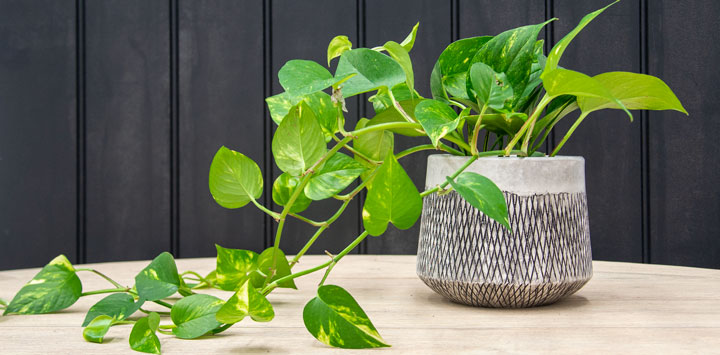Pothos Plant Guide: How To Care For Devil's Ivy
Devil's Ivy, Scindapsus, Epipremnum, Pothos - whatever you call it, this gorgeous group of vine-like plants is one of the most popular plant families for indoor gardeners, and for good reason. Here's a guide to caring for your pothos, plus a run-down of some of the stunning varieties we sell at Flower Power.
Pothos fast facts
Part of the araceae (aroid) family and closely related to monsteras and philodendrons, both Epipremnum and Scindapsus varieties are native to tropical rainforest climates in northern Australia, south-east Asia and the western Pacific. As rainforest understorey plants, they're used to a humid environment with filtered sunlight or shade. Appearing as a vine, these plants love to climb, and in their natural habitat, use their aerial roots to cling on to other trees as they climb north in search of sunlight. Mature specimens in the wild can reach up to 20 metres in height, with massive leaves that sometimes display monstera-like fenestrations. Kept in pots, they retain their juvenile leaf shape which tends to be much smaller and heart-shaped without fenestrations (the notable exception here is the dragon tail pothos). There are many varieties of pothos, some plain-coloured and others displaying beautiful variegation which intensifies in brighter light.
Pothos or Devil's Ivy care guidelines
This plant is popular for a number of reasons, not least because it's super low-maintenance and easy for beginner gardeners to grow. Here are a few pointers on how to grow Devil's Ivy and keep your plant happy.
Pot requirements
Pothos doesn't like wet feet, so your pot needs adequate drainage - however, most decorative indoor pots are built without drainage holes to protect your surfaces. For all indoor plants, we suggest leaving your new plant in its nursery pot and slipping that inside your decorative pot or basket. This will make it easier for you to water the plant and allow it to drain. Repot every two years or so into fresh potting mix, and a slightly larger nursery pot if your plant is root bound. Learn more about repotting here.
Potting mix
We always recommend using a premium indoor potting mix for best results. Our Supersoil Professional Indoor, Balcony and Hanging Basket Mix has been specially formulated to help your houseplants thrive.
Light requirements
When grown indoors, your pothos will tolerate low light but will produce the best results in bright but indirect sunlight. This might be a spot near a window that's covered by a sheer curtain, or a side table in a room with plenty of natural light positioned away from the window. Remember, for variegated varieties, the brighter the light, the better the variegation they'll produce, however full sun is not recommended as it can burn the delicate foliage.
Watering
If you aren't sure how often to water Devil's Ivy, here is one top tip: Don't overwater. It won't cope well with soggy soil, so allow it to dry out between waterings. A great rule of thumb is to poke your finger in the potting mix up to the first knuckle. If the mix feels wet, hold off on watering. If the mix is dry, that's your cue to water! Remove your pothos from its decorative pot and take it outdoors (the bath or shower will do the trick, too!). Wet the mix thoroughly - you'll know you've given it enough when you see water running through the drainage holes - and allow it to drain properly before returning it to its decorative pot indoors.
You may need to water once fortnightly on average, but remember that water uptake differs from plant to plant in different growing conditions and different seasons. In warmer weather or higher light conditions you may need to water more frequently, but in low light or cold weather once a month might be sufficient. Look at how your plant consumes water and allow that to dictate when you water!
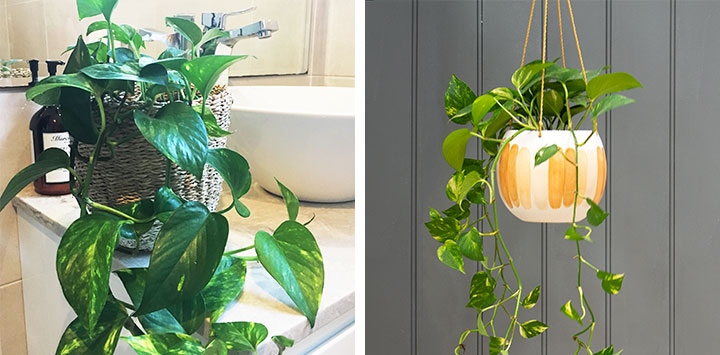
Pothos is an incredibly versatile plant. Pop it in the bathroom and have it spilling over a counter, or suspend it from a hanging hook!
Humidity
As rainforest plants, these guys love humidity! Keep them away from heaters or air conditioners which can dry the air out. Up the humidity around them by misting occasionally with water. For more tips on increasing humidity for indoor plants, read this article.
Fertiliser
If you're using a premium potting mix this will have some fertiliser in it, so your plant is off to a good start - but a little extra help never goes astray. During the active growing period (spring to early autumn), feed your hungry pothos with a liquid indoor plant fertiliser such as Osmocote Pour+Feed House Plant Food every couple of weeks to encourage growth. You should also apply a complete granular fertiliser every 6 to 12 months, as the fertiliser in the potting mix depletes. Want more info about feeding your indoor plants? This article has all you need.
Pruning
If you notice browning or yellowing leaves, remove them to allow the plant to focus on creating new foliage. If your pothos is looking leggy, we'd suggest that you cut it back. This can help stimulate growth, but you should only attempt it during the growing period. Cut the vine just after the last healthy leaf you'd like to leave on the plant. Pothos is generally fast-growing so you should be enjoying some beautiful new foliage in no time! Learn how to prune plants appropriately here.
Climbing
As mentioned above, these plants love to climb in their natural habitat. Training them onto a coco fibre totem pole creates a gorgeous upright look, and gives the aerial roots something to cling onto. You can also use hooks to help your pothos climb a wall or piece of furniture in your home.
Pothos varieties
Ready to dive in to the world of pothos? Here are some of the beautiful varieties you can find at Flower Power. Whether you like white or yellow variegation, vibrant colour or pinnate leaves, there's a variety for you. And now that you've got this guide on your side, caring for your new pothos will be a cinch!
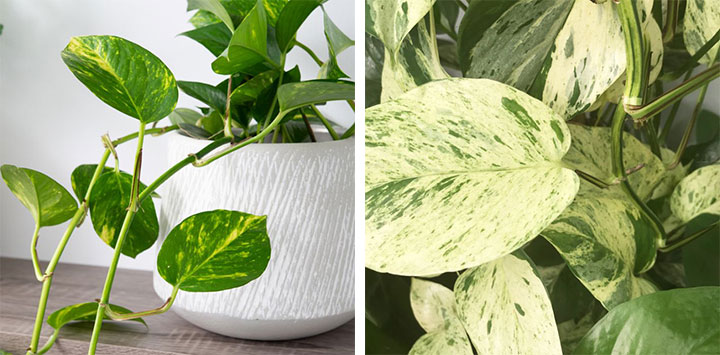
Devil's Ivy and Marble Queen.
Golden, or Devil's Ivy (Epipremnum aureum)
Perhaps the most iconic iteration of this plant, Golden Pothos or Devil's Ivy features larger, heart-shaped leaves which are a vibrant green with bright yellow marbled variegation.
Marble Queen (Epipremnum aureum 'Marble Queen')
Similar to the Devil's Ivy variety, Marble Queen's gorgeous, large heart-shaped leaves are cream and play host to green marbled variegation.
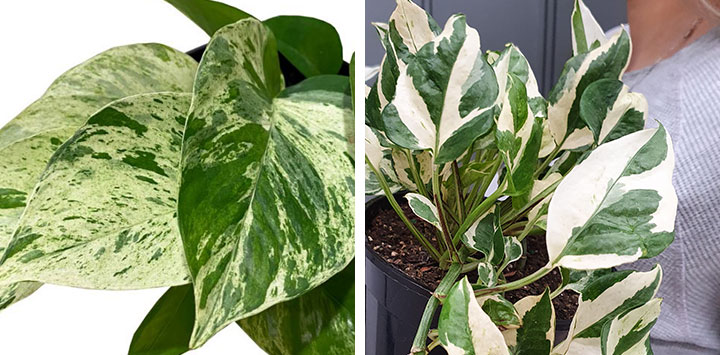
Snow Queen and Pearls & Jade.
Snow Queen (Epipremnum aureum 'Snow Queen')
Popular variety Snow Queen's mainly-white leaves feature marble-style variegation in deep green.
Pearls & Jade (Scindapsus var. 'Pearls and Jade')
Smaller-leaved Pearls & Jade features variegation that tends to alternate between blotching and marbling.
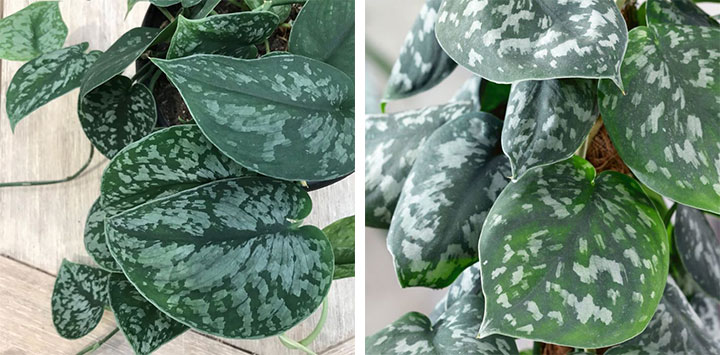
Satin and Silver Satin.
Satin (Scindapsus pictus 'Argyraeus')
Featuring beautiful, large, dark green heart leaves with a velvety texture and painterly silver spots, Satin Pothos is a standout in any collection.
Silver Satin (Scindapsus pictus 'Silver Satin')
Silver Satin is similar to Satin with more intense silver-white spotting over the foliage.
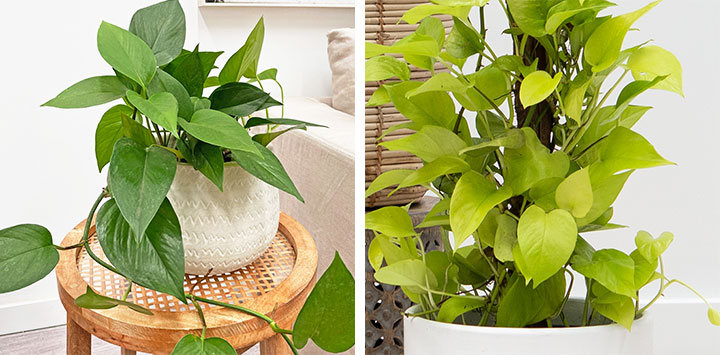
Jade and Goldilocks.
Jade (Epipremnum aureum 'Jade')
No variegation on this one - Jade just features plain, heart-shaped leaves in gorgeous green. The single deep shade helps the slightly ribbed texture of the leaves to stand out more.
Goldilocks (Epipremnum aureum 'Goldilocks')
Vibrant yellow foliage makes Goldilocks a stand-out variety.
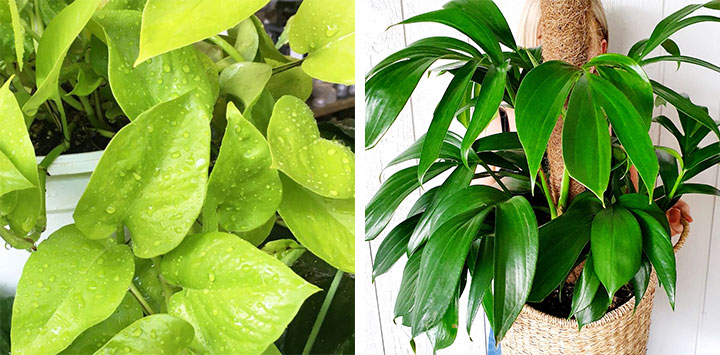
Neon and Dragon Tail.
Neon (Epipremnum aureum 'Neon')
This variety's almost-fluorescent chartreuse foliage gives it its Neon name and is a true show-stopper.
Dragon Tail (Epipremnum pinnatum)
This one is a little different - its large, glossy deep green leaves develop distinctive splits as the plant matures, giving it its common name, Dragon Tail.
Growing a gorgeous pothos? We'd love to see your pictures! Tag us @flowerpowergardencentres on Facebook or Instagram and share the love!


